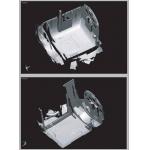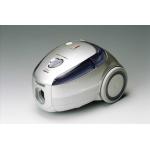Latest News
August 1, 2005
By Brett Duesing
Gone are the days when consumer products were content to dress down. Back then, their utilitarian beige or black boxes were the equivalent of a jeans-and-T-shirt no-nonsense fashion sense. Apple’s 1998 release of the iMac, an oft-cited touchstone of the new style consciousness, ushered in the idea of a machine that doubles as a piece of popular culture-sculpture. Now products feel underdressed in just a box.
As casings with soft, curvaceous lines have now become fashion de rigueur, often the shape of the product itself becomes as recognizable as a brand name. Sanyo Electronics, for example, recently jettisoned the boxy look of traditional vacuum cleaners in favor of a radical redesign (imagine a mini-iMac with a long, powerfully sucking hose). The Sanyo PowerBoy Canister Cleaner is the sleek result of a giant leap in product re-fashioning.
|
|
| The PowerBoy |
To mass-produce these plastic casings, however, requires another kind of jump. Irregular and curved parts pose a new set of engineering and manufacturing complexities. The advancement of 3D MCAD modelers have facilitated to a great degree the breaking of the boxy rules of design, but new manufacturing methods must be developed to make these visions into durable reality. For instance, since the casings fit against their internal circuitry as snugly as designer jeans, the engineering process for the inner circuitry of the product must closely mirror the development of exterior case. Further, rounded plastic is trickier to manufacture—instead of one straight-edge tolerance between parts, there are tolerances curving in three dimensions which must match up, along with the prospect of more numerous flaws in casting the complicated molds.
For the new PowerBoy product, these were the two major challenges of development among many changes in the manufacturing set-up, according to Sanyo’s manager of IT and Business Process Redesign, Mr. Yamaguchi. One technological change that allowed Sanyo to keep ahead of the curve, so to speak, was the adoption of laser digitizing.
Concurrent Design
To mesh the development of the inner and outer design aspects of the PowerBoy closely, the two Sanyo engineering teams used Styrofoam mock-ups of the design to check interference between the inner and outer parts. Alternations made to the physical model could be scanned by their laser digitizer, a VIVID 9I from Minolta, and Minolta’s reverse engineering software quickly performed a direct comparison between Sanyo’s 3D MCAD concept and its real-world counterpart.


A digital scan of a plastic part aligns to the specifications of the original 3D CAD model. The results are apparent at a glance: with out-of-spec regions shown by color plot, and specific points reported by quantified call-outs.
Traditionally (back in the box days), the interior design team had to wait for the exterior design to be finalized, but in the new compact vacuum, the two engineering streams ran concurrently. By using the quick and accurate reality checks that could get with the VIVID 9I digitizer, the separate MCAD projects could stay in tandem.
Historically, said Mr. Yumaguchi, this design process took about two weeks, but employing the VIVID 9i has enabled Sanyo to reduce the process by 60 percent, to four days.
In trial production stage of the PowerBoy, Mr. Yumaguchi decided against traditional CMM (coordinate measuring machines) technology, which uses touch sensors for quality inspection, in favor of a touch-free optical solution.
Filling curved molds with plastic presents the greater possibility of error in the finished piece. Manufactured parts might come out warped, under-filled, or with missing corners where the molding compound did not reach. Some errors such as voids can easily be recognized, but warping and some types of underfill are difficult to see. Automated inspection, in that case, gives advance warning of invisible structural flaws.
A CMM punches out single, minute point measurements over and over along the ridges of a curved plastic surface—a tedious process that becomes more laborious the greater twist and concavity of the inspection piece. A laser digitizer, however, scans these points at a comparable detail (easily exceeding Sanyo’s tolerance of 0.2mm) over the entire surface area in a few minutes, regardless of the shape of the object. Here the scans of the Minolta VIVID 9i proved much faster given topographic complexities of the product’s casing.
Just as in the reverse engineering of mockups, the cloud of 3D points can immediately be matched with the 3D MCAD design. In addition to acceleration of the physical inspection the Vivid9i provided in the production line, the Minolta software analyses automatically color-mapped the out-of-spec areas and highlighted specific points requiring attention by quantified call-outs. The inspection data also integrated well with Sanyo’s documentation standards and its statistical process control systems. After Sanyo defined its user format preferences, the Minolta system produced fully customized reports.
If more detailed investigation was necessary, Minolta’s utility software drew cross sections of the scan for further analysis. Once Sanyo engineers identified problem, the tooling shop worked to make necessary changes to improve the manufactured part, either by slight changes to operating conditions or new tooling. Sanyo production staff recognized that this kind of early correction enabled a vastly improved time-to-market for the PowerBoy vacuum.
Sanyo is addressing a few remaining integration issues, says Mr. Yamaguchi, in anticipation of using the VIVID 9i for routine inspection of parts. He plans to purchase additional units as the company explores additional ways to use laser digitizing for these purposes and in other departments within Sanyo. Sanyo has succeeded in implementing its concurrent engineering process and this has reduced total development time of its new vacuum cleaner models. Sanyo expects to continue using laser digitizers on new product casing design ideas.
Brett Duesing writes about high technology from his base in Colorado. Prior to his career as a writer, Duesing was a CAD and GIS worker bee. He readily admits he does not own a vacuum cleaner, but has seen and used them earlier in life. Send Brett your thoughts about this article by clicking here. Please reference Plastic Inspection August 2005.
Editor’s note: To view examples of how laser digitizing is applied in other industries and to learn more about the VIVID 9i laser digitizer by Minolta, click here.
Company Information
Konica Minolta USA
Mahwah, NJ
Subscribe to our FREE magazine, FREE email newsletters or both!
Latest News
About the Author
DE’s editors contribute news and new product announcements to Digital Engineering.
Press releases may be sent to them via [email protected].







